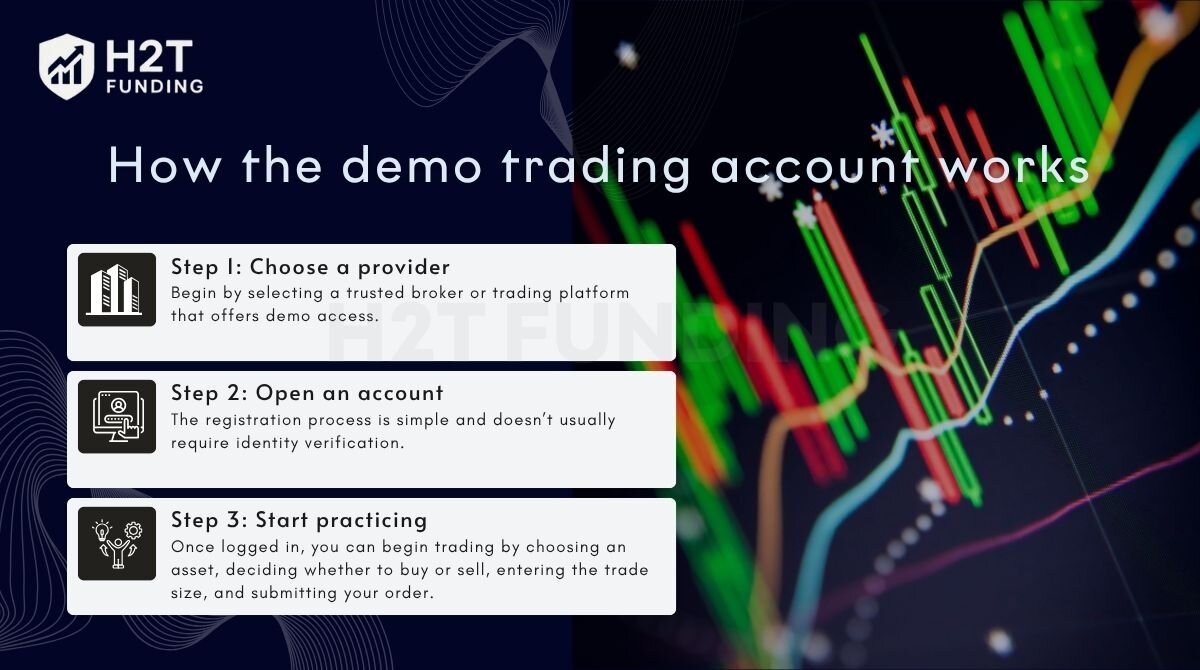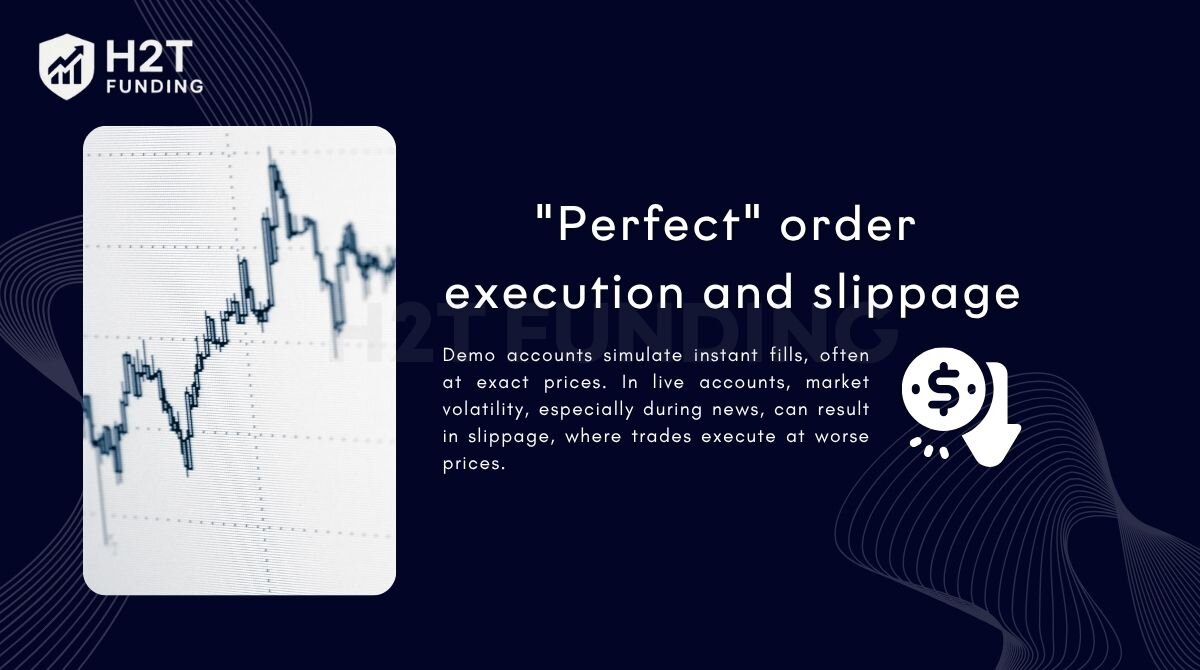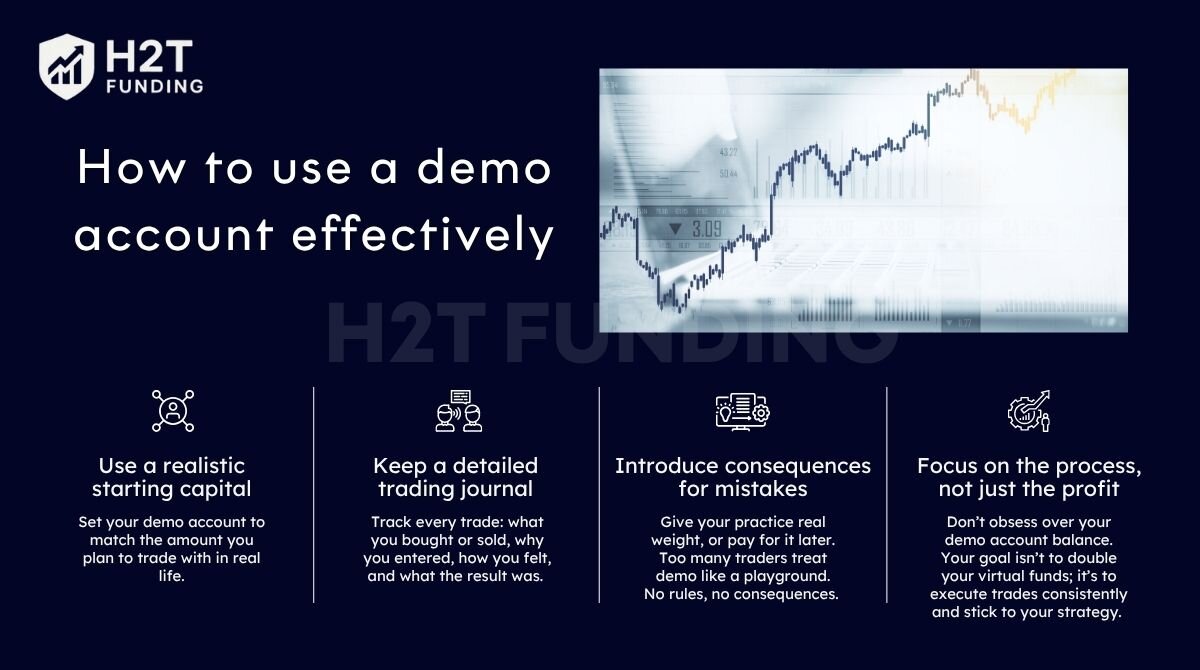I remember my first time looking at a trading chart. It was confusing, and I was terrified of making a costly mistake with one wrong click. That’s where a demo account saved me; it let me learn the ropes without losing a single cent.
If you’re feeling that same uncertainty, you’re in the right place. In this guide, you’ll get the demo trading account explained in simple terms. I’ll cover what it is, how it works, and most importantly, how to use it to build real skills for when you’re ready to trade with real money.
Key Takeaways
- A demo trading account lets you practice trading with virtual funds in real market conditions, with no financial risk involved.
- It’s ideal for testing strategies, learning platforms, and building confidence before moving to real money.
- Key differences from real accounts include no emotional pressure, no slippage, and often unrealistic capital sizes.
- To use it effectively, treat demo trades seriously, use realistic capital, journal your actions, and stay disciplined.
- Despite its limitations, a demo account is an essential tool for beginners when used with clear goals and self-awareness.
1. What is a demo account in trading?
A demo trading account is a risk-free trading environment that uses virtual money to simulate real market conditions. It lets you test trading strategies and explore the platform without putting any real funds at stake.

Imagine the thrill of a pilot stepping into a flight simulator, heart racing, hands slightly trembling, knowing they’re about to take off, but without the fear of crashing. Now, swap the cockpit for a trading platform.
That’s what a demo account offers: a safe, pressure-free space where you can learn the ropes, test your instincts, and even fail, all without losing a cent.
It’s your first step toward mastering the markets, with zero risk and unlimited opportunity to grow.
1.1. A risk-free learning environment
When you sign up for a demo trading account, you’re typically given $10,000 or even $100,000 in virtual funds. This isn’t real money, but that’s the point. It allows you to experiment freely, make mistakes, and learn how trading works without any financial risk.
1.2. Real market simulation
Even though the money isn’t real, the market data is. Prices of forex pairs, stocks, or crypto assets update in real time, just as they do on a live platform. That’s why demo accounts are ideal for testing strategies in real market conditions, especially on platforms like the DXtrade demo account or the best app for demo trading tools available today.
1.3. Platform familiarization
Using a demo account lets you explore every feature of a trading platform, without fear of breaking anything. From placing orders and adjusting position sizes to applying indicators or reading candlestick charts, you can try it all.
1.4. Strategy testing
A demo-funded account is also a great place to put your trading strategy to the test. Whether it’s a breakout approach or a mean reversion system, you can validate your plan in a simulated setting. The best part? You’ll see how it performs in real market conditions, without losing sleep or money, if it goes wrong.
In short, a demo account is a powerful starting tool, giving you a safe environment to build both knowledge and skill.
See also:
2. How it works: The demo trading account explained
Opening a demo trading account is a quick and straightforward process. Most platforms make it easy to get started within minutes, offering a seamless entry point for anyone looking to practice trading in a risk-free environment.

2.1. Step 1: Choose a provider
Begin by selecting a trusted broker or trading platform that offers demo access. Look for platforms that provide real-time market data, stable execution, and an intuitive user interface. These factors ensure your learning experience closely mirrors real-world trading without unnecessary complications.
2.2. Step 2: Open an account
The registration process is simple and doesn’t usually require identity verification. Most providers will ask for your email and a password to create your demo profile. Once completed, you’ll receive access to a simulated trading environment with virtual funds automatically loaded.
2.3. Step 3: Start practicing
Once logged in, you can begin trading by choosing an asset, deciding whether to buy or sell, entering the trade size, and submitting your order. It’s also a good time to practice setting stop-loss and take-profit levels, using charts, and analyzing market trends. These steps help build habits essential for real-world execution.
Read more of our articles:
3. The crucial differences: Demo vs real account
A demo account helps you build trading skills in a safe space, but it doesn’t replicate everything about live trading. Many new traders assume the transition will be seamless, only to be caught off guard.
Understanding the key differences between demo and real accounts can help you prepare mentally, emotionally, and technically for the real thing.
3.1. Emotional pressure is absent
On a demo account, losses are just numbers on a screen; they don’t sting. In contrast, losing $1,000 of real capital can trigger fear or greed, influencing your next move.
I still remember the first time I froze, staring at a EUR/USD position bleeding red, my strategy flashing exit now. But my hand wouldn’t move. I was paralyzed by the idea of locking in the loss. Funny how that never happened on demo.
That’s the truth few talk about: a demo account teaches you the mechanics, but not the emotions. It can’t simulate the pit in your stomach when real capital is on the line. And in trading, mastering your mindset is just as crucial as mastering your charts.
3.2. “Perfect” order execution and slippage
Demo accounts simulate instant fills, often at exact prices. In live accounts, market volatility, especially during news, can result in slippage, where trades execute at worse prices.

As you’ll often hear traders on forums like Reddit point out, demo accounts don’t have to deal with real-world liquidity, so they don’t have slippage. It’s a real factor that can slowly erode profits if you don’t account for it.
3.3. Unrealistic capital size
Most demo accounts give you $50,000 to $100,000 in virtual capital by default. But if you’re only planning to trade with $1,000 in real life, this creates a false sense of flexibility. Many traders over-leverage in demo and carry those bad habits into their real accounts, often with painful consequences.
Recognizing these three differences will let you treat a demo account as a valuable tool while preparing for the hard truths of live trading.
4. How to use a demo account effectively (and avoid bad habits)
A demo account is only as good as how you use it. To truly benefit from it, treat every trade like it matters. Here are four ways to bridge the gap between simulated and real trading, without carrying over bad habits.

4.1. Use a realistic starting capital
Set your demo account to match the amount you plan to trade with in real life. If your budget is $500, don’t practice with $100,000. This forces you to size trades properly, apply risk management, and simulate the pressure of working with limited capital.
4.2. Keep a detailed trading journal
Track every trade: what you bought or sold, why you entered, how you felt, and what the result was.
My own trading journal was a painful mirror at first. It showed a clear, destructive pattern: after one significant loss, I’d immediately place two or three smaller, unplanned trades trying to ‘win it back’ quickly, a classic case of revenge trading. Recognizing that habit in my journal was the first step to breaking it. This is the kind of self-awareness you need to build.
4.3. Introduce consequences for mistakes
Give your practice real weight, or pay for it later. Too many traders treat demo like a playground. No rules, no consequences. Then they’re shocked when they blow real money on their first live account.
Set rules now, before it hurts. For example: “If I break my trading plan, I’ll take 24 hours off.” That pause may feel frustrating, even pointless, but it’s far better than the gut-wrenching regret of watching your hard-earned savings vanish because you couldn’t follow your own rules.
4.4. Focus on the process, not just the profit
Don’t obsess over your demo account balance. Your goal isn’t to double your virtual funds; it’s to execute trades consistently and stick to your strategy. Process-driven practice builds habits that can survive the emotional highs and lows of live trading.
By turning your demo sessions into structured, intentional practice, you turn risk-free trading into real-world readiness.
Don’t miss it: What are the 4 trading sessions? A beginner’s guide
5. Is trading with a demo account worth it?
With all the limitations we’ve discussed, you might wonder, is using a demo account still worth your time? The short answer: absolutely, as long as you use it wisely. Below is a balanced look at its pros and cons to help you decide.
| Advantages | Disadvantages |
|---|---|
| 100% risk-free environment | Can create a false sense of security |
| Safely test any trading strategy | Doesn’t train real trading psychology |
| Explore platform features with no pressure | May encourage overtrading habits |
| Build confidence without losing money | Order execution is often too perfect |
Clearly, the benefits outweigh the downsides, provided you stay aware of its limits and treat your demo time with purpose.
6. Frequently asked questions (FAQs)
No. Any profit you make is purely virtual. A demo trading account is designed for practice only; it does not involve or generate real funds.
No. Since all the money in a demo account is simulated, you can’t withdraw any amount to your bank or real-life wallet.
The key differences are: No real money or emotional pressure. Instant execution with no slippage. Often higher starting capital than what you would use life.
Yes. Most reputable brokers and platforms offer free demo trading account access so that new users can explore their features and test strategies before committing real funds.
There’s no fixed timeline. Use a demo trading account until you can follow your strategy consistently and show stable results over at least 1–3 months. Confidence in your process, not just your profits, is the best sign you’re ready.
Demo accounts simulate real trading using virtual money. You get access to live market data and trading tools without risking your capital.
Yes. It helps beginners learn how platforms work and allows experienced traders to test strategies, completely risk-free.
You can build confidence, develop discipline, and refine your strategy before going live. It’s a safe way to learn from mistakes without losing money.
7. Conclusion
Think of your demo account as your personal trading lab. It’s the only place where you can test strategies, learn from mistakes, and build discipline without any real financial risk. Its true power isn’t in the virtual money you make, but in the good habits you build.
Now that you have the demo trading account explained, the real work begins. Take these lessons, treat your practice seriously, and you’ll build a strong foundation for success in the live markets.
To go deeper, explore our Prop Firm & Trading Strategies section of H2T Funding, where you’ll find real-world techniques, psychological insights, and practical steps to move from simulated success to real-world performance.




![Topstep Trades Closed By What Time [New Updated Guide]](https://cdn.h2tfunding.com/wp-content/uploads/Topstep-Trades-Closed-By-What-Time-New-Updated-Guide-768x429.jpg)
